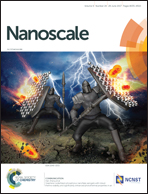Self-adapted and tunable graphene strain sensors for detecting both subtle and large human motions†
Abstract
Conventional strain sensors rarely have both a high gauge factor and a large strain range simultaneously, so they can only be used in specific situations where only a high sensitivity or a large strain range is required. However, for detecting human motions that include both subtle and large motions, these strain sensors can't meet the diverse demands simultaneously. Here, we come up with laser patterned graphene strain sensors with self-adapted and tunable performance for the first time. A series of strain sensors with either an ultrahigh gauge factor or a preferable strain range can be fabricated simultaneously via one-step laser patterning, and are suitable for detecting all human motions. The strain sensors have a GF of up to 457 with a strain range of 35%, or have a strain range of up to 100% with a GF of 268. Most importantly, the performance of the strain sensors can be easily tuned by adjusting the patterns of the graphene, so that the sensors can meet diverse demands in both subtle and large motion situations. The graphene strain sensors show significant potential in applications such as wearable electronics, health monitoring and intelligent robots. Furthermore, the facile, fast and low-cost fabrication method will make them possible and practical to be used for commercial applications in the future.



 Please wait while we load your content...
Please wait while we load your content...